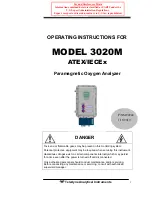
92
SCADA-Modbus® System Guidelines
D.4 Function Field
The function code field of an ASCII message frame, ranging from 1 to 255 decimals,
consists of two characters that represent the type of action the master is requesting from
the slave. Of these functions, the 940
Flow Meter currently supports function 3 (Read
Holding Registers). When a message is sent from the master to a slave device, the
function field tells the slave what kind of action to perform. For example, this may include
reading the channel values of Level and Velocity. When the slave responds to the master,
it echoes the function code field to indicate a normal response. In the event of an error,
such as parity error, LRC error, or a request that cannot be handled, the slave will not
respond and the master will eventually process a time-out condition.
D.5 Data Field
The data field of an ASCII message frame consists of
n
pairs of ASCII characters that
represent data sent to or from a slave device (flow meter). The data field contained in the
master request contains additional information that is required by the slave before any
action takes place. This may include channel register addresses, the number of registers
to read, and the actual byte count in the data field. For example, if a master requests that
the flow meter read the current status of a group of channels (function code 03), the data
field specifies the starting register and how many registers are to be read. If no error
occurs, the data field of the response from the meter to the master contains the data
requested.
D.6 LRC Field
The LRC field of an ASCII message frame consists of two ASCII characters that provide
an additional level of error checking to verify the integrity of the communication media.
The LRC field is one byte that contains an 8-bit binary value. The LRC value is calculated
by the transmitting device, which appends the LRC to the end of the message. The
receiving device recalculates the LRC and compares it against the LRC value of the
incoming message. If the two values are not equal, an error condition occurs. The LRC is
calculated by adding together successive 8-bit bytes of the message, discarding any
carries, and then complementing the result. The LRC is calculated by summing all values
in the ASCII message except for the leading ‘colon’ and ending <CR><LF>.
D.7 Communication Parameters
To successfully communicate with the 940 Flow Meter using Modbus ASCII, the
communication parameters of the master device must be set at 7 bits, Even Parity, and 1
Stop bit. The baud rate may be configured to any value offered by the 940 Flow Meter.
With the exception of baud rate, the communication parameters must not vary from this
format.
D.8 User Memory Customizing
The most familiar component of existing SCADA networks today is the Programmable
Logic Controller (PLC). Because the network integrator is most familiar with this type of
device, the flow meter emulation of an existing PLC simplifies the process of integrating
the manufacture’s instrumentation into the SCADA network. Modbus ASCII uses a
referencing system to identify the various types of memory inputs and outputs. Each
reference number has a leading digit that identifies its data type (discrete input, discrete
output, register input, register output) followed by a string of digits that indicates its
location in RAM (
).
Содержание 911
Страница 2: ......
Страница 14: ...12 General Information...
Страница 16: ...14 Getting Started...
Страница 42: ...40 Meter Installation...
Страница 44: ...42 Software and Communications...
Страница 58: ...56 Sensor Installation...
Страница 68: ...66 Maintenance...
Страница 72: ...70 Replacement Parts and Accessories...
Страница 76: ...74...
Страница 88: ...86 Channel Installation Options...
Страница 92: ...90 Batteries and Chargers...










































